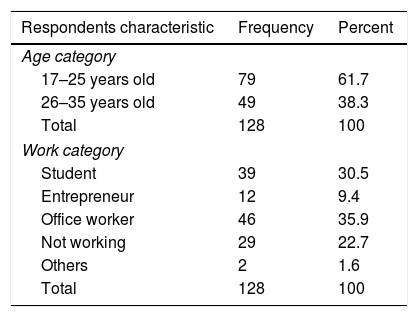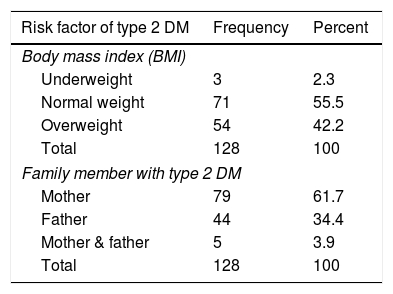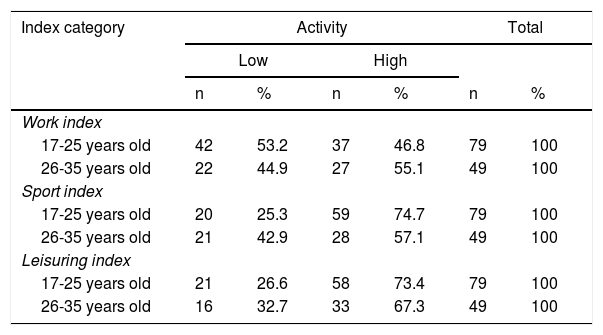Genetic has interrelated with the development of type 2 diabetes mellitus (DM). Individuals at high risk of type 2 DM have a strong family history and physical inactivity in their lifestyle. This study was aimed to determine physical activity among family members with risk of type 2 DM in Pekanbaru.
MethodDesign of the study was descriptive study. Number of sample were 128 respondents, which has taken by purposive sampling technique based on the inclusion criteria. This study was considered for respondent's comfort, privacy and confidentiality. The measuring tool for physical activity was modified Baecke Questionnaire, which has been tested for validity and reliability. It consists of work index, sport index, and leisure index. The analysis of this study was univariate analysis with frequency distribution in percentage form.
ResultsThe result showed that in adolescent age, 51.9% have middle activity, 27.8% have high activity, and 20.3% have low activity. In adult age, 61.2% have middle activity, 24.5% have low activity, and 14.3% have high activity.
ConclusionThis study recommends for family members who have risk of type 2 DM to start a healthier life by maintaining their physical activity especially in sport activities.
Diabetes can become a life-threatening disease. It is one of the leading causes of frequent hospitalization and early death. It currently affect 425 million adults, a total that is set to reach 629 million by 2045.1
The prevalence of diabetes is increasing worldwide for the past 3 decades, In particular, the prevalence of diabetes is growing most rapidly in low and middle income countries.2 About 346 million people worldwide have diabetes, with 80 percent of diabetes deaths occurring in low- and middle-income countries. Recent research has shown that urban populations in South Asia are increasingly at risk from developing type 2 diabetes mellitus (DM).3
Diabetes has devastating complications if not treated early and managed appropriately. Many with type 2 diabetes are diagnosed too late when complications are already present. This is unacceptable and needs to be addressed as a matter of urgency.1 WHO published the Global report on diabetes in April 2016, which calls for action to reduce exposure to the known risk factors for type 2 DM and to improve access to and quality of care for people with all forms of diabetes.2
The causes of type 2 DM are complex. Risk factors associated with tend to cluster within a family given that its members share common genetic background, lifestyle habits, social and physical environment.4 About 10% of people with type 2 diabetes have siblings who are also affected by the disease.5 Some studies have shown that if you have a father, mother or sibling who has diabetes, it is 2–6 times more risky than those who do not have a family with a history of type 2 DM.6
A study found that statistically significant correlation between family risk history on the prevalence of type 2 DM.7 If one parent suffers from DM, 15% of children are at risk of developing DM and 75% at risk if both parents affected by DM.8
The rise is due in part to increases in the number of people who are overweight, including an increase in obesity, and in a widespread lack of physical activity. Sudaryanto, Setyadi, and Frankilawati (2012) states that someone with less physical activity has 5 times the chance of developing DM disease than people who are sufficient in exercise.9 This study was aimed to determine physical activity among family members with risk of type 2 DM in Pekanbaru.
MethodThis research is a descriptive research. It was conducted in the working area of Puskesmas Harapan Raya, and starting from February to July 2018. The samples in this study were family members with high risk that having a family history with of type 2 diabetes. Number of sample were 128 respondents, which has taken by purposive sampling technique based on the inclusion criteria. This study was considered for respondent's comfort, privacy and confidentiality.
The measuring tool for physical activity was modified Baecke Questionnaire. It has been tested for validity and reliability. It consists of work index, sport index, and leisure index. Based on the total index value, the level of physical activity will be generated in the form of a category of mild activity with an index value of 56.5, moderate activity with an index value of 6.6–9.5, heavy activity with an index value >9.5.10
ResultsA total of 79 (61.7) respondents are 17–25 years old with various of work category (Table 1).
Table 2 showed that all respondents’ blood glucose in normal range, between 60 and 95g/dL.
Table 3 showed two risk factors that we recorded. Nearly half respondents are overweight (42.2%) and more than half respondent have mother with type 2 DM.
Table 4 showed that majority respondents have middle activity in both age category (adolescent age 51.9% and adult age 61.2%).
Respondent with age category 17–25 years old have low work activity, high sport activity and high leisure activity. Respondent with age category 26–35 years old have high work activity, high sport activity and high leisure activity (Table 5).
Analysis statistic for physical activities.
| Index category | Activity | Total | ||||
|---|---|---|---|---|---|---|
| Low | High | |||||
| n | % | n | % | n | % | |
| Work index | ||||||
| 17-25 years old | 42 | 53.2 | 37 | 46.8 | 79 | 100 |
| 26-35 years old | 22 | 44.9 | 27 | 55.1 | 49 | 100 |
| Sport index | ||||||
| 17-25 years old | 20 | 25.3 | 59 | 74.7 | 79 | 100 |
| 26-35 years old | 21 | 42.9 | 28 | 57.1 | 49 | 100 |
| Leisuring index | ||||||
| 17-25 years old | 21 | 26.6 | 58 | 73.4 | 79 | 100 |
| 26-35 years old | 16 | 32.7 | 33 | 67.3 | 49 | 100 |
According to risk factors of type 2 DM, obesity conditions have a significant relationship with the incidence of DM, where 80–85% of patients with type 2 diabetes are overweight. Not all people who are overweight will suffer from DM, but excessive body weight can cause an impact 10–20 years later.11
Genetic is another risk factor for type 2 DM. Santosa, Trijayanto, and Endiyono (2017) found that someone would be more quickly affected by DM if someone had a maternal lineage and tended to be affected by DM younger if they had the lineage from the mother and father.12 Other research also found that if one parent suffers from DM then has a risk of suffering from DM by 15%, if both parents suffer from DM increase to 75%.13
Type 2 DM can be prevented by doing some physical activity. Thirty minutes of moderate-intensity physical activity on most day and a healthy diet can drastically reduce the risk of developing type 2 DM.2 Moderate aerobic physical activity ≥150min/week was significantly associated with decreased risk of type 2 diabetes in all and non-obese subjects.14 However, in obese participants physical activity did not reduce risk of type 2 DM.
The results showed majority of respondents’ physical activity was in the category of middle physical activity (84.1%). The assumption was due to the age of the respondents studied being productive age where much activity is still carried out. In accordance with the theory that the school age range to the early adult physical activity of a person tends to increase until it reaches a maximum at the age of 25–30 years, then there will be a decrease in the functional capacity of the whole body approximately 0.8–1% per year.15
The type, intensity, and duration of beneficial physical activity associated with decreased risk of type 2 diabetes have not been clarified completely. In addition, there is controversy that whether physical activity can prevent diabetes independent of BMI and body fatness.14 Fikasari (2012) found that people who regularly exercise in the moderate category can reduce the risk of developing type 2 DM disease by 0.442 times compared to those who are irregular or lacking.16 The study conducted by Sukmaningsih (2014) showed that a person with low physical activity had a risk of 14,916 times compared to those with heavy physical activity on the incidence of type 2 DM.17 The more activity was carried out the lower fasting blood sugar levels.18
Regular physical activity can increase insulin sensitivity and increase glucose tolerance. Other benefits of doing physical activity are being able to increase body fat metabolism, increase blood pressure stability, and weight.19 Kurniawaty and Yanita (2013) in their study found that there was no relationship between physical activity and the risk of type 2 DM, but when associated between inactivity with obesity, hypertension, and family history of type 2 DM, results were obtained that exercise had a protective effect that could be achieved with weight reduction through increasing physical activity.6 IDF recommends physical activity at least between three to five days a week, for a minimum of 30–45min.1 The Indonesian Ministry of Health (2011) recommends to carry out physical activities or exercise for at least 30min every day with 3–5 times a week.20
Sports activities can provide direct benefits to blood sugar levels. The results of the research by Rondonuwu, Rompas, and Bataha (2016) found that there was a significant relationship between sports behaviour towards statistical control of blood sugar levels.21 Sports activities can increase the permeability of cell membranes to glucose when the muscles contract and can increase insulin sensitivity.22
Routine activities such as walking, cycling, 2–3 times a week for 20min every day and reducing sitting activities can have a positive impact on blood sugar.23 WHO (2016) also explained that blood sugar levels can be controlled by not doing sedentary activities (lack of motion) such as lingering in front of the television and lazing around.24
The results of leisure index found that majority respondents were doing high leisure activity. About 71.1% spent their free time watching television. Individuals who are less active are individuals who lack movement, including casual daily behaviour such as sitting, lying down, whether at work (in front of a computer, reading, etc.), at home (watching TV, playing games, etc.), but not including time sleep.
While there are a number of factors that influence the development of type 2 DM, it is evident that the most influential are lifestyle behaviours commonly associated with urbanization. These include consumption of unhealthy foods and inactive lifestyles with sedentary behaviour.1 The lack of motion behaviour is higher in urban areas compared to rural areas, namely 49.3%.24
ConclusionsThe results of the research were nearly half respondents are overweight, majority of respondents had mothers suffering from type 2 diabetes mellitus, and respondents’ physical activity was in the category of middle physical activity. This study recommends for family members who have risk of type 2 DM to start a healthier life by maintaining their physical activity especially in sport activities and maintain their weight.
Prof. Dr. Usman M. Tang, MS. Dean of Faculty of Nursing, Universitas Riau.
Peer-review of abstracts of the articles is under the responsibility of the Scientific Committee of Riau International Nursing Conference 2018. Full-text and the content of it is under responsibility of authors of the article.











